The Right Brushcutter Blades for Elevated Performance and Safety
Brushcutter blades come in various types, each offering distinct features and applications. Facilitating a comprehensive understanding of their functionalities will empower your clients to make confident decisions, ensuring they select efficient and safe tools tailored to their needs. In this guide, we will delve into crucial considerations for selecting the right brushcutter blade and provide essential safety measures to keep in mind while operating these powerful tools.
To assist your customers in choosing the appropriate brushcutter blade, it is essential to determine the type of vegetation they will be cutting and the specific machinery they intend to use. Additionally, other crucial factors to consider are the brushcutter's specifications, including the diameter of the central shaft hole, blade diameter, and guard sizing.
1. Matching the Brushcutter Blade to the Appliance
When making a blade selection, it is vital for your client to be aware of the blade diameter, as well as the diameters of both the tool's central shaft hole and its corresponding shaft. Emphasize that the diameter of the central shaft hole must match that of the tool's output shaft to guarantee a secure and stable fit during operation. Additionally, it is essential to remind your client to always utilize a protective cover while working to ensure safety during their cutting tasks.
2. Checking the Brushcutter
To ensure a smooth and safe cutting experience, it is crucial to remind your clients to conduct thorough checks before commencing any cutting task. Establishing a routine that addresses the following questions will help your clients to verify that everything is in proper working condition:
- Have the locking nut and filler cap been tightened properly?
- Do the throttle and stop button work smoothly?
- Is the blade still when the engine is idling?
- Is the carrying strap comfortable?
3. Protecting Yourself and Others
Operating a brushcutter can indeed be hazardous, with potential risks like the ejection of rocks or pebbles. To ensure the safety of clients, it is crucial to remind them to use Personal Protective Equipment (PPE) such as safety goggles, work gloves, ear protection, shin guards, and sturdy footwear. Following these safety precautions significantly reduces the risks associated with brushcutter operation.
3.1. Combat Operator Fatigue with Proper Support
In addition to physical hazards, operator fatigue is a considerable risk, especially with prolonged use of heavy brushcutters. To mitigate this, it is essential to advise customers to use a harness for essential support, minimizing muscle fatigue during extended work sessions. Properly adjusting the harness distributes the brushcutter's weight evenly across their shoulders, reducing strain and discomfort.
3.2. Adopt a Structured Cutting Approach for Safety
To promote safe and efficient brushcutter operation, recommend a structured approach by cutting in strips, working from the bottom of the area to the top, or vice versa. When working around obstacles such as trees and posts, using a nylon line trimmer head is the easiest and safest option to avoid damaging any bark.
3.3. Address Vibration Risks for Operator Comfort
It is crucial to address vibration risks in brushcutter blades, as they can pose significant concerns for both the operator and the machine. Excessive vibrations can lead to discomfort, fatigue, and potential health issues like hand-arm vibration syndrome (HAVS) during prolonged use. To tackle this, emphasize the importance of always balancing the blade if operators notice an increase in vibration levels. Check our very well balanced Kramp blades >>
A balanced blade ensures even weight distribution, reducing irregular movements and minimizing vibrations, resulting in a safer and more comfortable cutting experience. Regularly checking and balancing the blade will not only enhance operator safety but also prolong the brushcutter's lifespan by reducing stress on its components, leading to smoother operation and improved overall performance. We would like to remind you of the importance of providing blade balancing assistance and safety guidance to your customers.
Customers can opt for blade balancing either at your dealership or their workshop, provided they have a blade balancer and the necessary expertise. It's essential to emphasize the significance of proper blade balancing for a smooth and precise lawn cut. Read more about this in our article "Balancing Mower Blades" >>.
However, please always prioritize safety first. Whenever any work involves the cutting attachment of their appliance, remind your customers to strictly follow safety procedures. Wearing appropriate protective gear, such as gloves and safety goggles, is essential to avoid any potential accidents.
By following these safety tips and addressing vibration concerns, your clients can ensure a safer and more efficient brushcutting experience for their customers while also increasing the longevity and effectiveness of the equipment.
4. Mounting Brushcutter Blades
The mounting system for blades is different from one brushcutter to the next. Most brushcutters have a 20mm or 25.4mm arbour mount and left-hand threads in the drive shaft. The nut or bolt used to secure the blade can vary in size and shape depending on the different types of machinery. They tend to vary by brand.
View our range of left-hand bolts and nuts for brushcutters>>
Selection of Brushcutter Blades
Whether your client wants to cut tall grass, shrubbery or thin tree trunks, we can provide you with the right cutting blade for every application and every brushcutter. Our stable and robust blades have been tested and are of professional quality.
Grass Cutter Blades
Grass cutter blades are designed with two to eight teeth. They can be used to cut soft and fresh grass in spring and drier grass in summer. These blades are particularly suitable for cutting thick grass, ferns, nettles and dense vegetation. For a clean cut, remind your clients to regularly sharpen the blade. The overview down below provides a clear overview of the different grass cutter blades on the market and their area of use.
2-tooth brushcutter blade
|
|
 |
| 3-tooth brushcutter blade | Designed to thin out areas of tall grass, shrubs and wild vegetation For use on both sides |
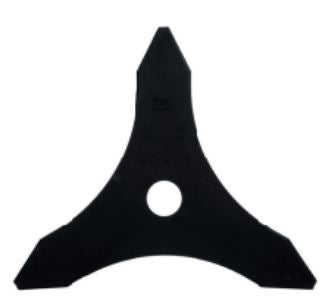 |
| 4-tooth brushcutter blade | Designed to cut small to medium-sized areas For use on both sides |
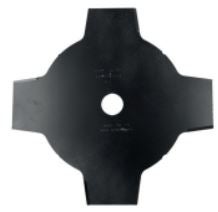 |
| 8-tooth brushcutter blade | Designed for flat cutting of areas of hard, dry grass, weeds, reeds and nettles For use on one side only |
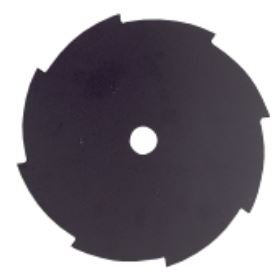 |
Find grass cutter blades in our shop >>
Mulching Blades
Mulching blades are designed with two or three teeth. They have a specialized design with downward curved tips, giving the blade a wing shape. While the blade rotates, the airflow created by the wing design rotates and cuts the clippings multiple times in the mowing chamber. The fine clippings are then distributed back onto the soil. The wing shape of the blade prevents clumping and blockages that are common with straight blades.
This type of blade is suitable for chipping thin branches and recycling them as mulch. See the overview down below for the different types and areas of use:
2-tooth mulching blade
| Designed to thin out and chip prickly hedges, brambles and bushes For use on one side only
|
 |
| Curved 2-tooth mulching blade | Curved shredding blade for large brushcutters, designed to thin out and chip thorny hedges, brambles. For use on one side only
| 
|
| 3-tooth mulching blade | Designed to thin out and chip prickly hedges, brambles, shrubs and bushes For use on one side only
|
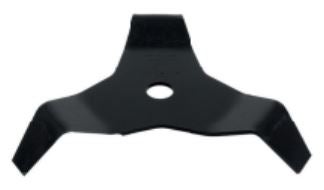 |
Find mulch blades in our shop >>
Saw tooth Blades
Saw tooth blades have sharp serrated teeth that resemble those of a chainsaw. These blades are designed to cut through particularly dense vegetation. They are effective for cutting bushy areas, dense undergrowth or thorny hedges, such as dog rose.
Circular saw blade with maxi chisel tooth
| Designed for clearing and cutting hedges, thick bushes or thin tree trunks
|
 |
| Circular saw blade with XRT chisel tooth | Anti-kickback teeth, designed for clearing and cutting hedges, thick bushes or thin tree trunks
|
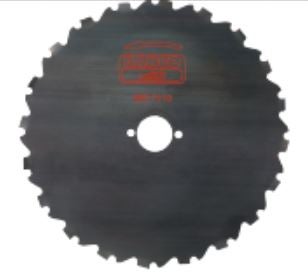 |
| Circular saw blade with EIA chisel tooth | Designed for clearing and cutting hedges, thick bushes or thin tree trunks
|
 |
Find saw tooth blades in our shop >>
Share this Article with your Customers!
Spread this article among your customers through your website, newsletters, social media platforms, or any other communication channels you use. Together, we can enhance the overall customer experience and showcase the value of our products and services.
Questions?
Would you like to learn more about the brushcutter blades? Contact our product specialist, or email us at the knowledge centre. If you are a private customer seeking products mentioned in this article, find a Kramp dealer near you.

